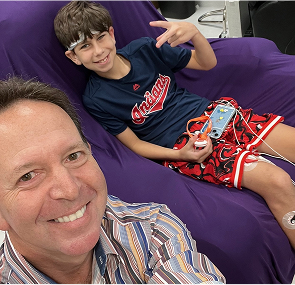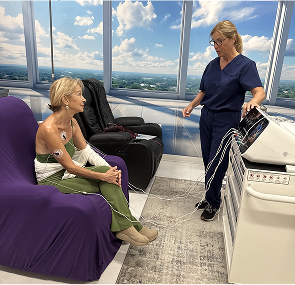Natural Nerve Pain Relief: 7 Daily Habits for Lasting Comfort

Nerve pain, also called neuropathic pain, arises when the peripheral nervous system or spinal cord sends faulty pain signals to the brain. Unlike muscle aches, it creates sharp, burning, or tingling sensations even without an injury.
What are the types of nerve pain?
- Acute nerve pain – short-term, often after surgery or trauma.
- Chronic nerve pain – ongoing, linked to conditions like diabetes, shingles, or nerve compression.
Who is at risk for nerve pain?
People with nerve damage, pain, diabetes, autoimmune conditions, chemotherapy exposure, or spinal disorders have higher risk. Symptoms include numbness, burning sensation, tingling, and lowered pain threshold.
Understanding nerve pain sets the stage for why non-invasive treatments like Scrambler Therapy can help.
How Scrambler Therapy Helps Nerve Pain
Scrambler Therapy, also called the Calmare device, is a non-invasive treatment that uses electric stimulation to send new “non-pain” messages through sensory nerves.
How does it work?
- Electrodes placed on the skin deliver mild signals.
- These signals cause pain modulation by interrupting faulty pain messages.
- Over repeated sessions, the brain undergoes neuroplasticity—learning to interpret the new signals as safe, not painful.
Why choose Scrambler Therapy for nerve pain?
- It helps patients with chronic nerve pain who failed medication.
- It reduces reliance on opioids.
- It supports nerve reprogramming and brain retraining for long-term comfort.
Daily habits amplify these effects by lowering inflammation and supporting nerve recovery.
Why Daily Habits Matter for Nerve Pain Relief
Yes. A structured pain management plan that includes nutrition, movement, stress control, and sleep creates a foundation for nervous system stability.
How do habits support Scrambler Therapy?
- Reduce symptom flare-ups.
- Improve body resilience to pain.
- Support neural repair and inflammation control.
Consistency matters. A nerve pain daily routine ensures scrambler therapy for nerve pain achieves better outcomes.
Now let’s explore the seven most effective habits.
Habit #1 – Anti-Inflammatory Diet for Nerve Pain
Food impacts nerve fibers and inflammation pathways. High sugar or processed foods worsen neuroinflammation, while nutrient-rich meals promote nerve repair.
Best anti-inflammatory foods for nerve pain:
- Omega-3s: Salmon, chia seeds, walnuts.
- Turmeric and curcumin: Natural anti-inflammatory spices.
- Antioxidant-rich produce: Berries, leafy greens, cruciferous vegetables.
- Whole foods: Low glycemic load carbs, whole grains.
Foods to avoid:
- Processed sugar (increases nerve irritation).
- Fried foods (raise inflammation).
- Excess alcohol (damages nerve cells).
Eating a nerve pain diet reduces symptoms and supports therapy outcomes.
Habit #2 – Gentle Movement and Stretching
Physical activity promotes blood flow, reduces stiffness, and enhances nerve pathways. Unlike high-impact workouts, gentle movement protects fragile nerve fibers.
Effective exercises for nerve pain:
- Nerve gliding routines to ease pressure on nerves.
- Yoga sequences for flexibility and stress reduction.
- Aerobic conditioning like swimming or walking for circulation.
Benefits:
- Release endorphins (natural pain relievers).
- Reduce muscle tension.
- Support mobility and joint health.
Daily stretching and physical therapy for nerve pain complement scrambler sessions.
Habit #3 – Quality Sleep and Nerve Pain Regulation
Yes. Deep sleep cycles promote tissue repair and regulate pain perception. Poor sleep increases nighttime pain and sleep disruption, worsening recovery.
How to improve sleep for nerve pain sufferers:
- Maintain a consistent circadian rhythm.
- Use sleep hygiene practices: dark, cool rooms and no screens before bed.
- Support melatonin levels naturally with regular bedtime.
Chronic sufferers often face nerve pain and insomnia, but prioritizing restorative sleep improves healing outcomes.
Habit #4 – Stress Management to Reduce Nerve Pain
Stress elevates cortisol, overactivates the autonomic nervous system, and increases pain sensitivity. This creates a cycle of anxiety and chronic nerve pain.
Best stress-reduction techniques:
- Mindfulness meditation: Lowers stress-induced pain.
- Breathwork: Stimulates the vagus nerve for relaxation.
- Yoga and gentle stretching: Combine physical and emotional relief.
Building a nervous system reset routine lowers the pain threshold and enhances therapy results.
Habit #5 – Hydration and Detoxification for Nerve Health
Nerves require electrolytes and cellular hydration to transmit signals effectively. Dehydration causes cramping, tingling, and worsens pain sensitivity.
Tips for hydration balance:
- Drink water consistently throughout the day.
- Limit caffeine and alcohol, which act as diuretics.
- Support kidney function and lymphatic system detoxification with herbal teas.
Detox benefits: Eliminating toxin buildup reduces inflammation and improves nerve signaling.
Habit #6 – Consistent Use of Scrambler Therapy
Therapy works best with a structured treatment cycle. Skipping sessions lowers cumulative relief and disrupts nerve regeneration.
Best practices for scrambler therapy schedule:
- Stick to recommended session intervals.
- Track recovery in a journal.
- Communicate with your provider about response variability
Patients who show treatment consistency often report higher success rates and reduced pain scores over time.
Habit #7 – Supplementation to Support Nerve Healing
Certain vitamins and natural compounds act as neuroprotective agents. They strengthen nerve sheaths, reduce oxidative stress, and fill nutritional gaps.
Evidence-based supplements for nerve pain:
- B vitamins: Support nerve function and repair.
- Alpha-lipoic acid: Reduces oxidative stress.
- Magnesium: Helps with muscle relaxation and nerve conduction.
- Curcumin: Anti-inflammatory and antioxidant benefits.
Patients using nerve support supplements often experience better therapy outcomes.
Real Stories: Success With Daily Habits and Scrambler Therapy
How do patients describe their results?
- One patient reported a 50% drop in pain scale scores after combining diet changes with scrambler sessions.
- Another case study showed improved quality of life through daily exercise and stress management.
- Patient testimonials highlight reduced chronic nerve pain and longer-lasting relief with consistent daily habits.
Scrambler therapy reviews often note that lifestyle changes accelerate improvements and sustain recovery.
Frequently Asked Questions (FAQs) About Nerve Pain and Daily Relief
What is the fastest way to relieve nerve pain naturally?
Combining scrambler therapy with anti-inflammatory diet, movement, and stress control provides the quickest relief.
Can nerve pain go away with daily habits?
Yes. While some cases need medical treatment, consistent daily habits reduce symptoms and promote long-term healing.
How long does Scrambler Therapy take to relieve nerve pain?
Most patients notice changes within 5–10 sessions, but full relief requires consistency.
Are supplements for nerve pain actually effective?
Yes. Supplements like B vitamins and alpha-lipoic acid support nerve repair, but results vary by deficiency and health status.
What foods worsen nerve pain?
High sugar, fried foods, alcohol, and heavily processed meals often trigger nerve pain flare-ups.
Start Your Pain-Free Journey Today





